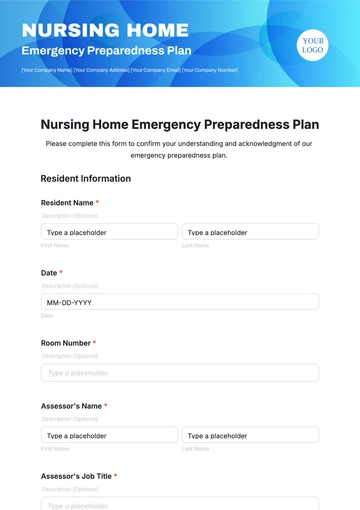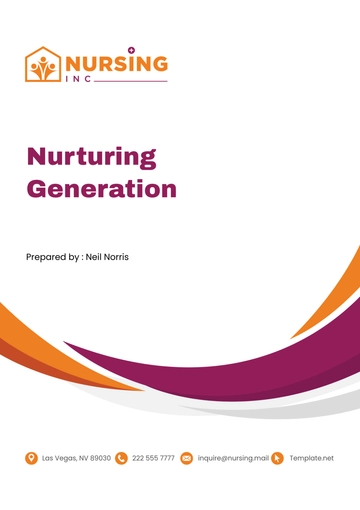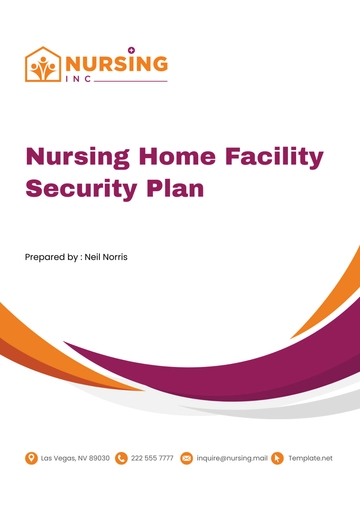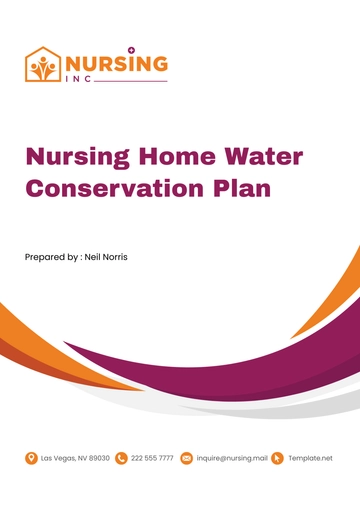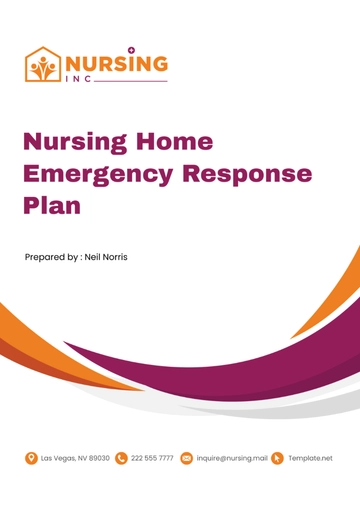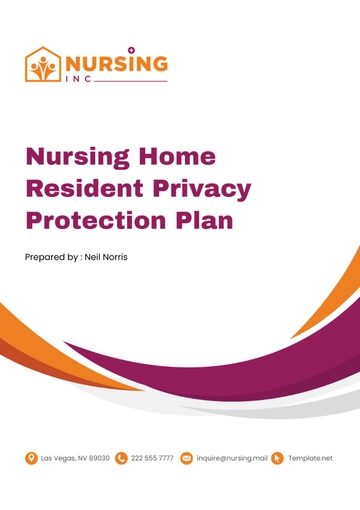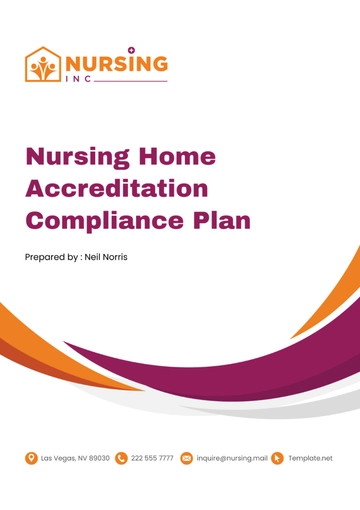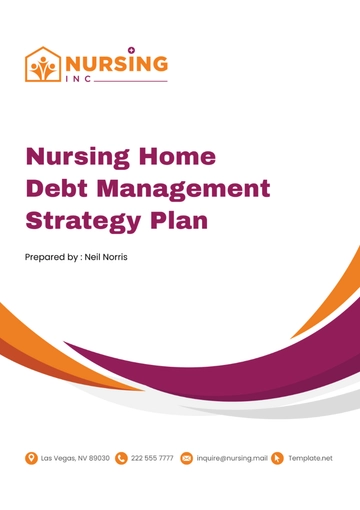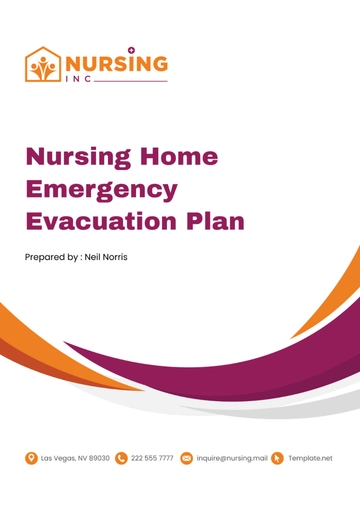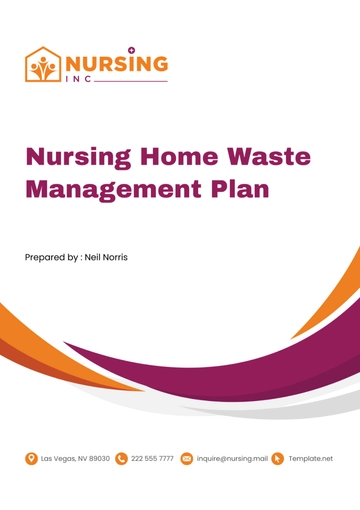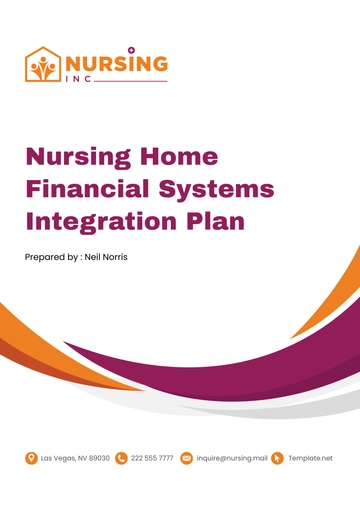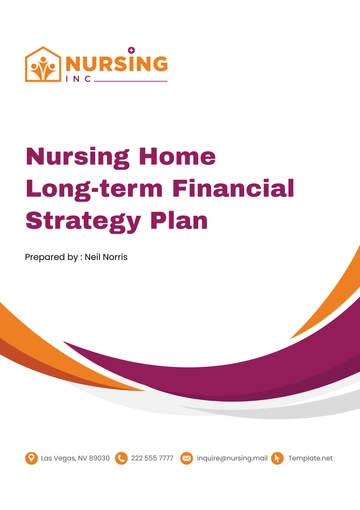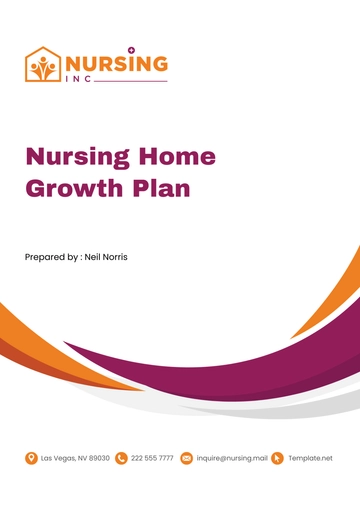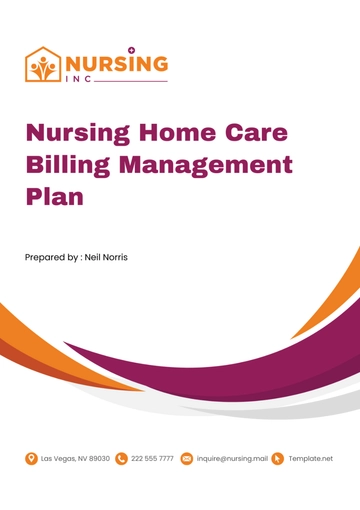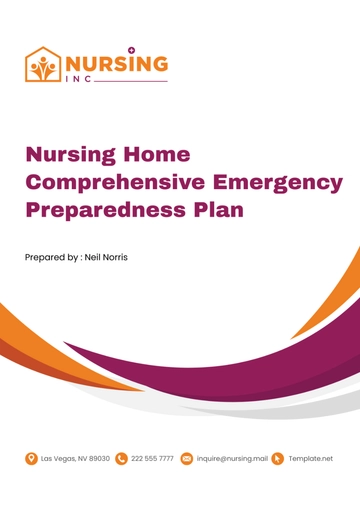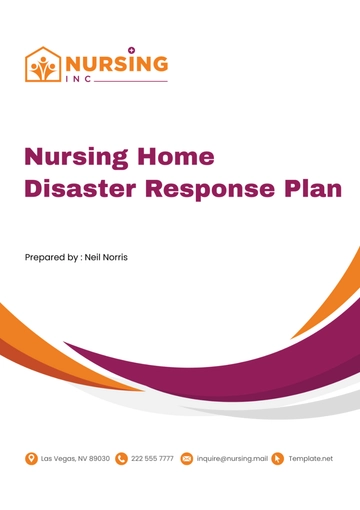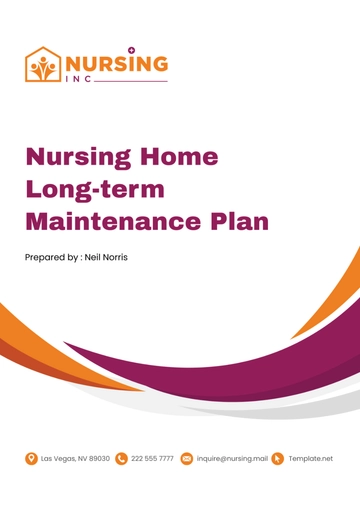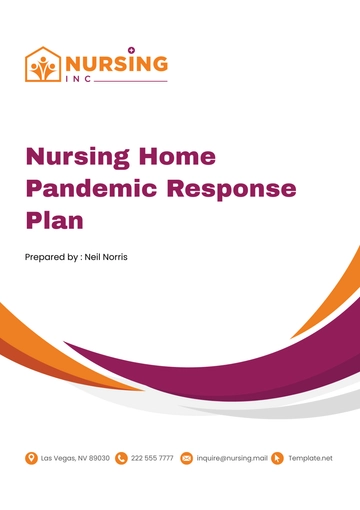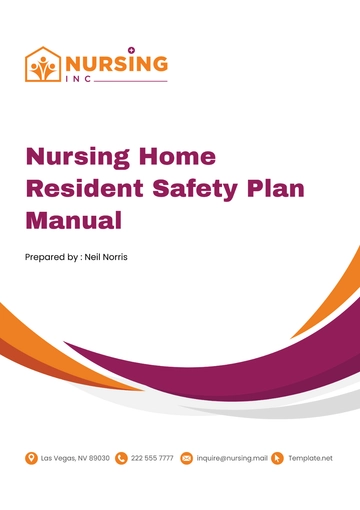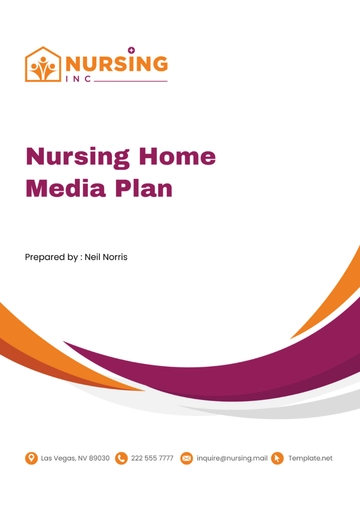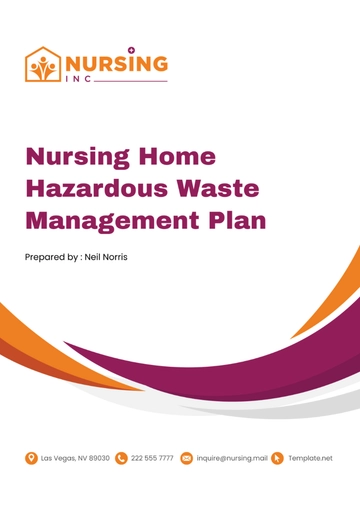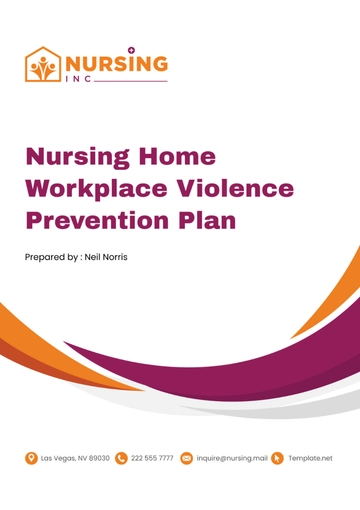Free Nursing Home Comprehensive Emergency Preparedness Plan
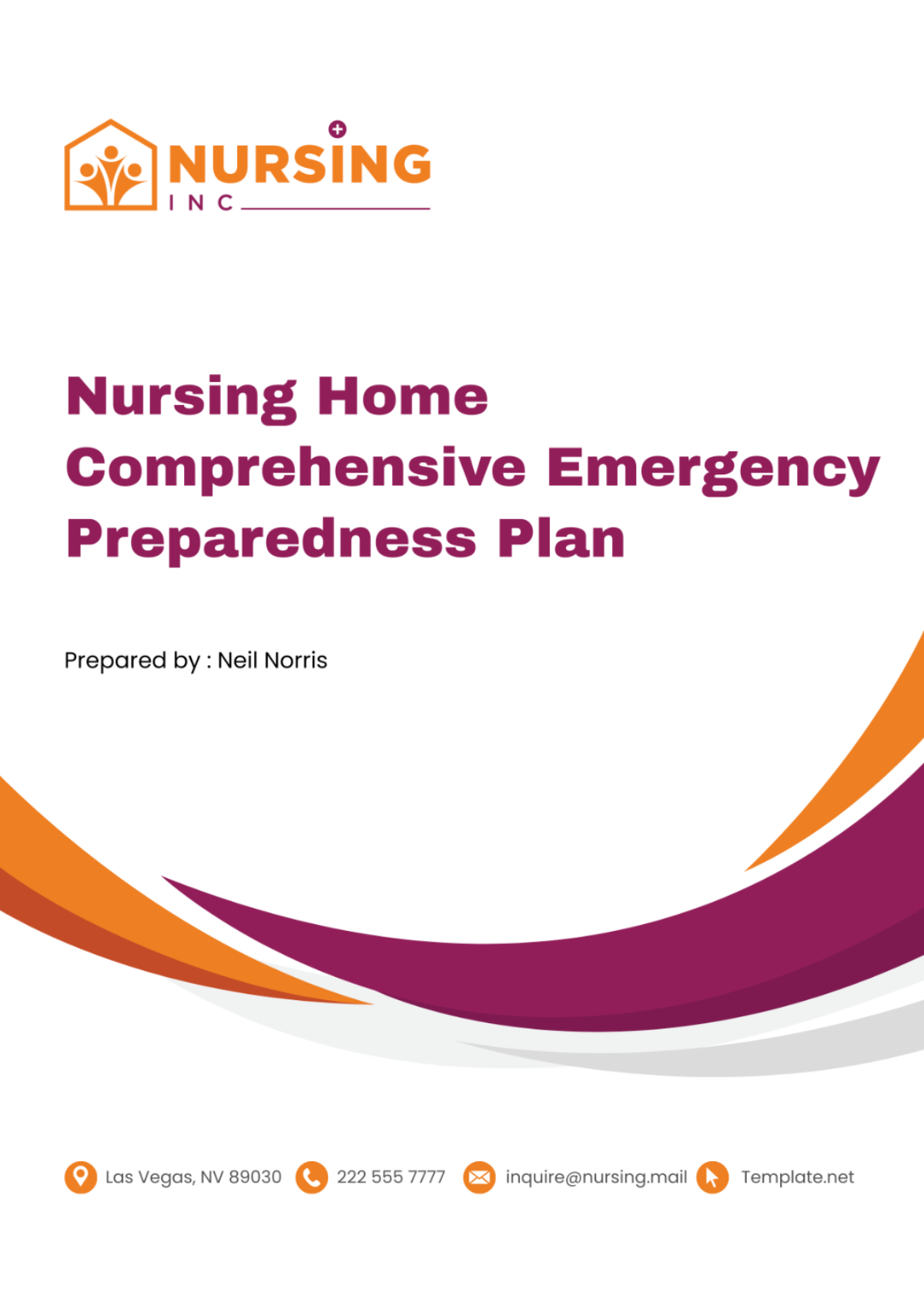
I. Introduction
A. Purpose
The purpose of the Nursing Home Comprehensive Emergency Preparedness Plan (CEPP) is to establish a systematic approach to safeguarding the lives and well-being of residents, staff, and visitors during emergencies. This plan outlines protocols, procedures, and responsibilities to mitigate risks, respond effectively, and facilitate recovery in various emergency scenarios. By implementing this plan, [Your Company Name] aims to:
Ensure the safety and security of residents, staff, and visitors.
Minimize disruptions to essential services and operations.
Coordinate with external agencies and stakeholders for effective emergency response and recovery efforts.
Promote a culture of preparedness and resilience within the nursing home community.
B. Scope
This CEPP applies to all [Your Company Name] Nursing Home facilities, including [Facility Name(s)]. It encompasses preparedness, response, and recovery measures for natural disasters, technological emergencies, and human-caused incidents. The plan is designed to be adaptable to different types and scales of emergencies, ensuring comprehensive protection for our community.
C. Definitions
Key terms used throughout the plan:
Term | Definition |
|---|---|
Emergency | Any situation posing an immediate threat to health, life, property, or the environment. |
Evacuation | The organized relocation of residents to a safe location in response to an imminent threat. |
Shelter-in-place | The practice of seeking protection indoors during an emergency, such as severe weather or hazardous materials incidents. |
Incident Command System (ICS) | A standardized management system used to coordinate emergency response efforts and establish a clear chain of command. |
Vulnerable Population | Residents with special needs or conditions that may require additional assistance during emergencies, such as those with mobility impairments, cognitive disorders, or medical dependencies. |
II. Risk Assessment
A. Identification of Hazards
A comprehensive risk assessment is conducted to identify potential hazards that may affect [Your Company Name] Nursing Home facilities. This includes, but is not limited to, the following:
Natural disasters: Earthquakes, floods, hurricanes, tornadoes, wildfires, severe storms.
Technological emergencies: Power outages, utility failures, hazardous material spills, infrastructure failures.
Human-caused incidents: Acts of violence, terrorism, civil disturbances, mass casualty incidents.
Infectious disease outbreaks: Pandemics, epidemics, communicable diseases.
B. Vulnerability Analysis
Vulnerable populations within the nursing home, including residents with mobility impairments, cognitive disorders, chronic illnesses, and dependency on medical devices, are identified and assessed for their specific needs during emergencies. Special attention is given to those requiring assistance with evacuation, communication, medication management, and personal care.
The vulnerability analysis considers factors such as age, health status, functional abilities, language barriers, and cultural preferences to ensure inclusivity and equity in emergency planning and response efforts.
C. Probability and Impact Analysis
The likelihood and potential impact of each identified hazard are evaluated to prioritize preparedness efforts and allocate resources effectively. Factors considered include historical data, geographical location, facility infrastructure, resident demographics, and available support services.
Probability and impact assessments inform decision-making regarding emergency response strategies, resource allocation, and risk mitigation measures. By understanding the potential consequences of various hazards, [Your Company Name] can develop targeted plans and protocols to minimize harm and ensure the safety of residents, staff, and visitors.
III. Emergency Response Plan
A. Emergency Notification and Communication
Establish protocols for initiating emergency notifications to staff, residents, and families. This includes:
Implementing a multi-channel communication system (e.g., text messages, emails, phone calls) to disseminate timely alerts and updates.
Designating individuals responsible for activating the emergency notification system and maintaining communication with external stakeholders, such as emergency services and regulatory agencies.
Providing training to staff on the use of communication tools and protocols during emergencies.
B. Evacuation Procedures
Develop comprehensive evacuation procedures to ensure the safe and orderly relocation of residents to designated assembly areas or alternative care facilities. Key components include:
Identifying primary and secondary evacuation routes based on facility layout, accessibility, and potential hazards.
Establishing evacuation protocols for different scenarios (e.g., fire, natural disaster, hazardous material release) and assigning roles and responsibilities to staff members.
Conducting regular evacuation drills to familiarize staff and residents with evacuation procedures, assess readiness, and identify areas for improvement.
Coordinating with transportation providers, emergency services, and community partners to facilitate timely evacuation and relocation efforts.
C. Shelter-in-Place Protocols
Develop and implement shelter-in-place protocols to protect residents and staff from external threats, such as severe weather or environmental hazards. This involves:
Identifying safe areas within the facility that provide protection from external hazards (e.g., designated storm shelters, reinforced rooms).
Stockpiling emergency supplies, including food, water, medical supplies, and personal protective equipment (PPE), to sustain residents and staff during extended shelter-in-place situations.
Establishing procedures for monitoring environmental conditions, communicating with external authorities, and providing updates to residents and families during shelter-in-place incidents.
D. Medical Emergency Response
Ensure staff members are trained and equipped to respond effectively to medical emergencies and provide appropriate care to residents. This includes:
Providing training in first aid, cardiopulmonary resuscitation (CPR), and emergency medical procedures to designated staff members.
Maintaining adequate supplies of medical equipment, medications, and emergency response kits throughout the facility.
Establishing protocols for assessing and triaging residents' medical needs during emergencies and coordinating with external medical resources, such as emergency medical services (EMS) and hospitals.
E. Incident Command Structure
Implement an Incident Command System (ICS) to establish a clear chain of command and coordination structure during emergencies. Key components include:
Designating Incident Commanders and establishing incident management teams responsible for overseeing emergency response efforts.
Developing incident action plans (IAPs) to guide response activities, allocate resources, and track progress.
Conducting regular training and exercises to familiarize staff with ICS principles and procedures and ensure effective coordination during emergencies.
IV. Training and Education
A. Staff Training
Provide comprehensive training sessions on emergency preparedness, response procedures, and individual roles and responsibilities. This includes:
Conducting initial orientation training for new staff members and ongoing refresher training for existing staff.
Covering topics such as emergency evacuation procedures, first aid and medical response, communication protocols, and resident care during emergencies.
Incorporating hands-on exercises, simulations, and scenario-based training to enhance staff preparedness and decision-making skills.
B. Resident and Family Education
Develop educational materials and conduct informational sessions for residents and their families on emergency procedures and evacuation plans. This includes:
Distributing emergency preparedness guides and communication tools to residents and families upon admission and during regular intervals.
Hosting educational workshops and drills to familiarize residents with evacuation routes, shelter-in-place procedures, and emergency contacts.
Providing assistance to residents with special needs or language barriers to ensure they understand and can participate in emergency preparedness activities.
V. Resource Management
A. Personnel
Maintain updated contact information for all staff members and emergency response personnel. This includes:
Establishing a centralized database or system to store staff contact details, including phone numbers, email addresses, and emergency roles.
Designating individuals responsible for maintaining and updating the staff contact list regularly to ensure accuracy and accessibility during emergencies.
Conducting periodic training sessions to familiarize staff with their emergency roles and responsibilities and ensure readiness to respond effectively.
Identifying backup personnel and volunteers who can be mobilized to support emergency response efforts during staff shortages or large-scale incidents.
B. Equipment and Supplies
Inventory and maintain emergency supplies, including food, water, medical supplies, and communication equipment. This involves:
Conducting regular inspections and audits of emergency supplies to ensure adequate stock levels and readiness for use.
Establishing protocols for replenishing and replacing supplies as needed, based on expiration dates, usage rates, and changing needs.
Securing agreements with suppliers and vendors to ensure timely delivery of essential supplies during emergencies and periods of high demand.
Providing training to staff on the proper use and maintenance of emergency equipment and supplies, including fire extinguishers, first aid kits, and communication devices.
C. Facilities and Infrastructure
Ensure the resilience and functionality of nursing home facilities and infrastructure to withstand and respond to emergencies. This includes:
Conducting regular maintenance and inspections of building systems, such as fire alarms, generators, HVAC systems, and electrical systems.
Implementing measures to mitigate physical hazards and vulnerabilities, such as securing heavy furniture, reinforcing windows and doors, and installing emergency lighting.
Developing contingency plans for temporary sheltering or relocation in the event of facility damage or unsafe conditions.
Collaborating with facility management, engineering, and maintenance staff to address facility-specific risks and prioritize infrastructure improvements to enhance emergency preparedness.
VI. Continuity of Operations
A. Business Continuity Planning
Identify critical functions and processes that must be maintained during emergencies to ensure the continuity of essential services and operations. This includes:
Conducting a business impact analysis (BIA) to assess the potential consequences of disruptions to key business activities and identify recovery priorities.
Developing business continuity plans (BCPs) with specific strategies and procedures to mitigate risks, restore operations, and minimize downtime.
Establishing alternate work locations, backup systems, and communication channels to support remote operations and decision-making during emergencies.
Testing and exercising BCPs regularly to validate their effectiveness, identify gaps, and improve response capabilities.
B. Data Backup and Recovery
Implement data backup procedures to ensure the security and availability of essential records and information. This involves:
Establishing backup schedules and protocols for regularly copying and storing critical data, including resident records, medical files, and administrative documents.
Utilizing secure off-site or cloud-based storage solutions to protect data from loss or corruption due to physical damage or system failures.
Testing data backup systems and recovery processes to verify their reliability and integrity and ensure timely restoration of essential services.
Training staff on data management best practices, including data encryption, password protection, and disaster recovery procedures, to safeguard sensitive information and maintain compliance with regulatory requirements.
VII. Evaluation and Revision
A. Performance Evaluation
Conduct post-event debriefings and evaluations to assess the effectiveness of emergency response efforts. This includes:
Gathering feedback from staff, residents, families, and external stakeholders involved in the emergency response to identify strengths, weaknesses, and areas for improvement.
Reviewing incident reports, logs, and documentation to analyze response times, resource utilization, communication effectiveness, and compliance with established protocols.
Identifying lessons learned and best practices from real-world incidents and incorporating them into future training, procedures, and revisions of the Emergency Preparedness Plan.
Documenting findings and recommendations from performance evaluations to inform decision-making and enhance overall emergency preparedness and response capabilities.
B. Plan Review and Revision
Regularly review and update the Emergency Preparedness Plan to reflect changes in regulations, best practices, and facility operations. This includes:
Establishing a schedule for periodic review and revision of the plan, considering factors such as regulatory requirements, facility expansions or renovations, and lessons learned from emergency drills and incidents.
Convening a multidisciplinary planning committee or task force to oversee the review process and solicit input from key stakeholders, including staff, residents, families, and community partners.
Incorporating feedback, recommendations, and lessons learned from performance evaluations, regulatory agencies, accreditation bodies, and industry standards into plan revisions.
Communicating updates and changes to all relevant stakeholders, providing training and guidance on revised procedures, roles, and responsibilities, and ensuring awareness and compliance with the updated plan.
C. Drill and Exercise Evaluation
Analyze the outcomes of emergency drills and exercises to identify strengths and weaknesses in the emergency preparedness program. This includes:
Conducting debriefings with participants to discuss observations, challenges, and opportunities for improvement identified during drills and exercises.
Reviewing drill documentation, including scenario objectives, performance metrics, and participant feedback, to assess compliance with established protocols and procedures.
Identifying areas of success and areas for improvement in communication, coordination, resource management, decision-making, and resident care.
Developing action plans to address findings and recommendations from drill evaluations, including revisions to procedures, additional training, equipment upgrades, and policy changes, to enhance overall readiness and response capabilities.
VIII. Public Relations and Community Engagement
A. Public Relations
Develop and maintain positive relationships with the media, government agencies, community organizations, and other stakeholders to facilitate effective communication and collaboration before, during, and after emergencies. This includes:
Establishing a designated spokesperson or communications team responsible for liaising with the media and providing timely and accurate information to the public and stakeholders.
Creating a communications plan with protocols for issuing press releases, conducting media briefings, and managing social media channels to disseminate emergency updates, instructions, and safety information.
Collaborating with local emergency management agencies, public health departments, and community partners to coordinate messaging, share resources, and leverage mutual support networks during emergencies.
Engaging in proactive outreach and public education campaigns to raise awareness of emergency preparedness, response procedures, and community resources, fostering a culture of resilience and mutual assistance.
B. Community Engagement
Foster partnerships and collaboration with community organizations, businesses, schools, and faith-based groups to enhance emergency preparedness, response, and recovery efforts. This includes:
Participating in community forums, workshops, and planning committees to share expertise, resources, and best practices in emergency management and preparedness.
Establishing mutual aid agreements, memoranda of understanding (MOUs), and formal partnerships with neighboring facilities, hospitals, and emergency services to coordinate response and support efforts during emergencies.
Providing training, resources, and technical assistance to community members, organizations, and vulnerable populations to empower them to prepare for and respond to emergencies effectively.
Engaging in outreach activities, such as health fairs, disaster drills, and community events, to build trust, resilience, and social cohesion within the community and promote a sense of shared responsibility for emergency preparedness and response.
- 100% Customizable, free editor
- Access 1 Million+ Templates, photo’s & graphics
- Download or share as a template
- Click and replace photos, graphics, text, backgrounds
- Resize, crop, AI write & more
- Access advanced editor
Prepare for emergencies comprehensively with the Nursing Home Comprehensive Emergency Preparedness Plan Template from Template.net. Editable and customizable, it outlines protocols for various emergency scenarios, including natural disasters and medical crises. Tailor it effortlessly using our Ai Editor Tool for personalized plans. Ensure readiness and protect residents and staff with this essential template.
You may also like
- Finance Plan
- Construction Plan
- Sales Plan
- Development Plan
- Career Plan
- Budget Plan
- HR Plan
- Education Plan
- Transition Plan
- Work Plan
- Training Plan
- Communication Plan
- Operation Plan
- Health And Safety Plan
- Strategy Plan
- Professional Development Plan
- Advertising Plan
- Risk Management Plan
- Restaurant Plan
- School Plan
- Nursing Home Patient Care Plan
- Nursing Care Plan
- Plan Event
- Startup Plan
- Social Media Plan
- Staffing Plan
- Annual Plan
- Content Plan
- Payment Plan
- Implementation Plan
- Hotel Plan
- Workout Plan
- Accounting Plan
- Campaign Plan
- Essay Plan
- 30 60 90 Day Plan
- Research Plan
- Recruitment Plan
- 90 Day Plan
- Quarterly Plan
- Emergency Plan
- 5 Year Plan
- Gym Plan
- Personal Plan
- IT and Software Plan
- Treatment Plan
- Real Estate Plan
- Law Firm Plan
- Healthcare Plan
- Improvement Plan
- Media Plan
- 5 Year Business Plan
- Learning Plan
- Marketing Campaign Plan
- Travel Agency Plan
- Cleaning Services Plan
- Interior Design Plan
- Performance Plan
- PR Plan
- Birth Plan
- Life Plan
- SEO Plan
- Disaster Recovery Plan
- Continuity Plan
- Launch Plan
- Legal Plan
- Behavior Plan
- Performance Improvement Plan
- Salon Plan
- Security Plan
- Security Management Plan
- Employee Development Plan
- Quality Plan
- Service Improvement Plan
- Growth Plan
- Incident Response Plan
- Basketball Plan
- Emergency Action Plan
- Product Launch Plan
- Spa Plan
- Employee Training Plan
- Data Analysis Plan
- Employee Action Plan
- Territory Plan
- Audit Plan
- Classroom Plan
- Activity Plan
- Parenting Plan
- Care Plan
- Project Execution Plan
- Exercise Plan
- Internship Plan
- Software Development Plan
- Continuous Improvement Plan
- Leave Plan
- 90 Day Sales Plan
- Advertising Agency Plan
- Employee Transition Plan
- Smart Action Plan
- Workplace Safety Plan
- Behavior Change Plan
- Contingency Plan
- Continuity of Operations Plan
- Health Plan
- Quality Control Plan
- Self Plan
- Sports Development Plan
- Change Management Plan
- Ecommerce Plan
- Personal Financial Plan
- Process Improvement Plan
- 30-60-90 Day Sales Plan
- Crisis Management Plan
- Engagement Plan
- Execution Plan
- Pandemic Plan
- Quality Assurance Plan
- Service Continuity Plan
- Agile Project Plan
- Fundraising Plan
- Job Transition Plan
- Asset Maintenance Plan
- Maintenance Plan
- Software Test Plan
- Staff Training and Development Plan
- 3 Year Plan
- Brand Activation Plan
- Release Plan
- Resource Plan
- Risk Mitigation Plan
- Teacher Plan
- 30 60 90 Day Plan for New Manager
- Food Safety Plan
- Food Truck Plan
- Hiring Plan
- Quality Management Plan
- Wellness Plan
- Behavior Intervention Plan
- Bonus Plan
- Investment Plan
- Maternity Leave Plan
- Pandemic Response Plan
- Succession Planning
- Coaching Plan
- Configuration Management Plan
- Remote Work Plan
- Self Care Plan
- Teaching Plan
- 100-Day Plan
- HACCP Plan
- Student Plan
- Sustainability Plan
- 30 60 90 Day Plan for Interview
- Access Plan
- Site Specific Safety Plan
